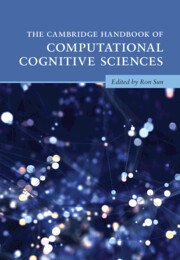Book contents
- The Cambridge Handbook of Computational Cognitive Sciences
- Cambridge Handbooks in Psychology
- The Cambridge Handbook of Computational Cognitive Sciences
- Copyright page
- Contents
- Preface
- Contributors
- Part I Introduction
- Part II Cognitive Modeling Paradigms
- Part III Computational Modeling of Basic Cognitive Functionalities
- Part IV Computational Modeling in Various Cognitive Fields
- Part V General Discussion
- 36 Model Validation, Comparison, and Selection
- 37 Philosophical Issues in Computational Cognitive Sciences
- 38 An Evaluation of Computational Modeling in Cognitive Sciences
- Index
- References
38 - An Evaluation of Computational Modeling in Cognitive Sciences
from Part V - General Discussion
Published online by Cambridge University Press: 21 April 2023
- The Cambridge Handbook of Computational Cognitive Sciences
- Cambridge Handbooks in Psychology
- The Cambridge Handbook of Computational Cognitive Sciences
- Copyright page
- Contents
- Preface
- Contributors
- Part I Introduction
- Part II Cognitive Modeling Paradigms
- Part III Computational Modeling of Basic Cognitive Functionalities
- Part IV Computational Modeling in Various Cognitive Fields
- Part V General Discussion
- 36 Model Validation, Comparison, and Selection
- 37 Philosophical Issues in Computational Cognitive Sciences
- 38 An Evaluation of Computational Modeling in Cognitive Sciences
- Index
- References
Summary
Computer modeling of specific psychological processes began over fifty years ago. Cognitive scientists do not use computers merely as tools, but also as inspiration about the nature of mental processes. Computational cognitive science has a long way to go. There are many unanswered questions.However, cognitive scientists believe that the mind/brain is in principle intelligible in terms of whatever turns out to be the best theory of what computers can do. The overview of cognitive science given in this chapter should suffice to show that significant progress has been made.
- Type
- Chapter
- Information
- The Cambridge Handbook of Computational Cognitive Sciences , pp. 1228 - 1249Publisher: Cambridge University PressPrint publication year: 2023



